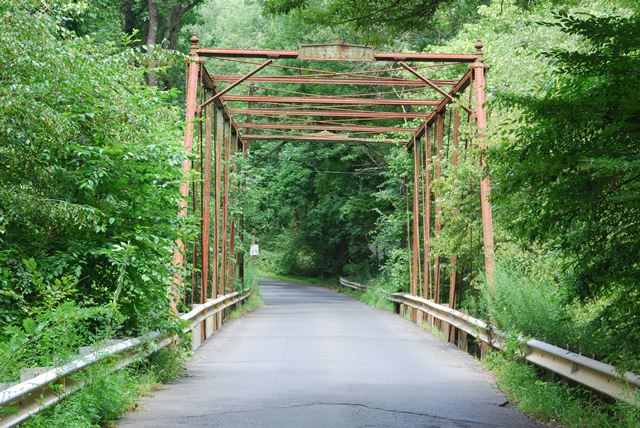We Recommend:
Bach Steel - Experts at historic truss bridge restoration.
BridgeHunter.com Phase 1 is released to the public! - Visit Now
Province Line Road Bridge

Primary Photographer(s): Elaine Deutsch
Bridge Documented: August 18, 2013
Rural: Monmouth County, New Jersey: United States
1891 By Builder/Contractor: Phoenix Bridge Company of Phoenixville, Pennsylvania, Dean and Westbrook of New York, New York, Agents
1994
110.0 Feet (33.5 Meters)
111.0 Feet (33.8 Meters)
15.4 Feet (4.69 Meters)
1 Main Span(s)
1300U53

View Information About HSR Ratings
Bridge Documentation
View Archived National Bridge Inventory Report - Has Additional Details and Evaluation
This bridge is one of only two Phoenix column through truss bridges in New Jersey. This bridge retains its builder plaque crediting Dean and Westbrook, however the plaque uses a less elaborate style than found on many bridges built by this company which erected bridges manufactured by the Phoenix Bridge Company. This bridge is noted for retaining decorative finials. The historic integrity of the truss appears to be good, however it has had bents added under the deck at the floor beams to bear the load, rendering the trusses non-functional.
Information and Findings From New Jersey's Historic Bridge InventoryDiscussion of Bridge The 7-panel, 110', pin-connected Pratt thru truss has Phoenix Column upper chords, vertical, and upper laterals, finials atop the portals, loop-forged eye-bar lower chords and diagonals, built-up floorbeams, and cast-iron connecting nodes. In 1943 the bridge was underpinned with steel stringers on timber piles. The span was constructed with patented Phoenix sections by well-known engineers Dean & Westbrook. It is a historically and technologically distinguished example of a rare type.
The truss bridge has been altered by the addition of underpinning. Timber piles capped by a longitudinal beam stiffening member have been placed under each end of each floor beam. Additional timber floor beams supported on wood block risers and the longitudinal beams have been added at mid panel. The structure is in effect a six-span continuous deck girder bridge. Historical and Technological Significance: The bridge is historically and technologically significant as an example of late-nineteenthcentury iron truss bridge technology using patented Phoenix Column sections (criterion C). The pin-connected Pratt thru truss became the most successful and technologically important of the late-nineteenth century iron truss bridge types. Furthermore, the Province Line Road truss employs wrought iron Phoenix Columns. The patented Phoenix Column was developed in 1864 by David Reeve of the Phoenix Iron Company of Phoenixville, Pennsylvania. Its significance in the history of civil engineering was as a leading contribution to the substitution of wrought iron for cast iron in the compression members of bridges and buildings. It enjoyed tremendous popularity in the 1880s, and was important in the general acceptance of metal truss bridge technology. The Province Line Road bridge was fabricated in 1891 by the Phoenix Bridge Company of Phoenixville, Pennsylvania and erected by Dean and Westbrook of New York City. Dean and Westbrook acted as agents for Phoenix Bridge Company highway truss bridges from the mid-1880s to the mid-1890s. Phoenix Bridge Company records show that Dean and Westbrook built over 70 Phoenix Column truss highway bridges in New Jersey from 1885 to 1895, and at least six including the Province Line Road bridge are extant (10XXF65, Hamden Road over South Branch of Raritan River, 1885, Franklin Twp., Hunterdon Co.; 10XXF82, Lower Lansdowne Road over Capoolong Creek, 1885, Franklin Twp., Hunterdon Co.; 1300U47, Walnford Mill Road over Crosswicks Creek, 1885, Upper Freehold Twp., Monmouth Co.; 020042A, Doty Road over Ramapo River, 1891, Oakland Borough, Bergen Co.; 020044B, Elm Street over Hackensack River, 1892, Oradell Borough, Bergen Co.). Of the six surviving trusses only two, the Province Line Road and Lower Lansdowne Road bridges are thru trusses, the others are pony trusses. Because of the engineering significance of the Phoenix section, the bridge is evaluated as significant despite the fact that it was underpinned in 1943 and no longer functions as a truss bridge. The historic trusses appear to survive in basically unaltered condition. Boundary Description and Justification: It is the trusses that are individually significant, not the later underpinning or altered substructure. The boundary is limited to the trusses themselves. Bibliography:
Burnham, Alan. "Forgotten Engineering: The Rise and Fall of the Phoenix Column." Architectural Record. April, 1959.
Discussion of Surrounding Area The single-lane bridge spans a tree-lined creek in a rural wooded setting. Nearby, but out of sight of the bridge, are nurseries and scattered 19th- and 20th-century houses. About 1/2 mile south is the crossroads village of Ellisdale. Bridge Considered Historic By Survey: Yes |
This bridge is tagged with the following special condition(s): Phoenix Columns
![]()
Photo Galleries and Videos: Province Line Road Bridge
Bridge Photo-Documentation
Original / Full Size PhotosA collection of overview and detail photos. This gallery offers photos in the highest available resolution and file size in a touch-friendly popup viewer.
Alternatively, Browse Without Using Viewer
![]()
Bridge Photo-Documentation
Mobile Optimized PhotosA collection of overview and detail photos. This gallery features data-friendly, fast-loading photos in a touch-friendly popup viewer.
Alternatively, Browse Without Using Viewer
![]()
Maps and Links: Province Line Road Bridge
Coordinates (Latitude, Longitude):
Search For Additional Bridge Listings:
Bridgehunter.com: View listed bridges within 0.5 miles (0.8 kilometers) of this bridge.
Bridgehunter.com: View listed bridges within 10 miles (16 kilometers) of this bridge.
Additional Maps:
Google Streetview (If Available)
GeoHack (Additional Links and Coordinates)
Apple Maps (Via DuckDuckGo Search)
Apple Maps (Apple devices only)
Android: Open Location In Your Map or GPS App
Flickr Gallery (Find Nearby Photos)
Wikimedia Commons (Find Nearby Photos)
Directions Via Sygic For Android
Directions Via Sygic For iOS and Android Dolphin Browser
USGS National Map (United States Only)
Historical USGS Topo Maps (United States Only)
Historic Aerials (United States Only)
CalTopo Maps (United States Only)

